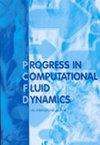渗透率非线性变化的多孔介质中Riga板效应对纳米流体流动的热力学分析
IF 0.5
4区 工程技术
Q4 MECHANICS
引用次数: 1
摘要
本文对铜-水纳米流体在倾斜通道内多孔介质中的流动进行了全面的研究。假定多孔介质的渗透率沿通道宽度呈指数变化。考虑了通道壁上的纳维尔滑移,同时壁上也受到对流加热,尽管不是对称的。通道的下壁假定是由里加板制成的,里加板是一种由电极和磁铁组成的新型电磁板,可以产生平行的洛伦兹力。适当的变换应用于控制方程,使它们是非量纲化的。然后用同伦分析法对得到的方程进行求解。对于控制方程的简化形式,得到了与先前给出的结果相似的解析解。讨论了各种流动参数的图形表示。经典哈特曼数对流动的影响是非常显著的,可以在减少熵和表面摩擦中起关键作用。本文提出的流动方案在文献中尚属首次。本文章由计算机程序翻译,如有差异,请以英文原文为准。
Thermodynamic analysis of Riga plate effect on nanofluid flow in porous medium with nonlinearly varying permeability
A comprehensive study of a copper-water nanofluid flowing through a porous medium embedded in an inclined channel is presented in the current article. The permeability of the porous medium is assumed to vary exponentially across the width of the channel. Navier slip at the channel walls is taken into account while the walls are also convectively heated, albeit asymmetrically. The lower wall of the channel is assumed to be made of a Riga plate, a new type of electromagnetic plate made of electrodes and magnets, inducing a plate parallel Lorentz force. Appropriate transformations are applied to the governing equations such that they are non-dimensionalised. The obtained equations are then solved using the homotopy analysis method. For a reduced form of the governing equations, analytical solutions are obtained which are similar to previously presented results. Graphical presentations are discussed for various flow parameters. The impact of the classical Hartman number on the flow is seen to be very significant and can play a pivotal role in reduction of entropy and skin friction. The flow scheme presented in the present article is presented for the first time in literature.
求助全文
通过发布文献求助,成功后即可免费获取论文全文。
去求助
来源期刊
CiteScore
1.50
自引率
14.30%
发文量
33
审稿时长
7.5 months
期刊介绍:
CFD is now considered an indispensable analysis/design tool in an ever-increasing range of industrial applications. Practical flow problems are often so complex that a high level of ingenuity is required. Thus, besides the development work in CFD, innovative CFD applications are also encouraged. PCFD''s ultimate goal is to provide a common platform for model/software developers and users by balanced international/interdisciplinary contributions, disseminating information relating to development/refinement of mathematical and numerical models, software tools and their innovative applications in CFD.
Topics covered include:
-Turbulence-
Two-phase flows-
Heat transfer-
Chemical reactions and combustion-
Acoustics-
Unsteady flows-
Free-surfaces-
Fluid-solid interaction-
Navier-Stokes solution techniques for incompressible and compressible flows-
Discretisation methods and schemes-
Convergence acceleration procedures-
Grid generation and adaptation techniques-
Mesh-free methods-
Distributed computing-
Other relevant topics

 求助内容:
求助内容: 应助结果提醒方式:
应助结果提醒方式:


